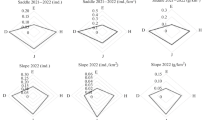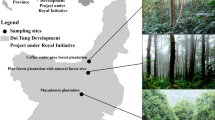Abstract
Kubo people of Papua New Guinea sometimes grew Dioscorea yams in mounds of forest litter that were made as egg-incubation sites by birds (Megapodiidae).' The small yam plots were included within larger banana gardens and, in the latter, it was yams, not bananas, that took precedence in the gardening decisions of people. The technique would be viable in the absence of a larger garden. It is interpreted as an expression of an ancient pattern of small-scale plant domestication.
Similar content being viewed by others
References
Allen, J. (1977). The hunting Neolithic: Adaptations to the food quest in prehistoric Papua New Guinea. In Megaw, J. V. S. (Ed.),Hunters, Gatherers and First Fanners Beyond Europe. Leicester University Press, Leicester.
Bailey, R. C., Head, G., Jenike, M., Owen, B., Rechtman, R., and Zechenter, E. (1989). Hunting and gathering in tropical rain forest: Is it possible?American Anthropologist 91: 59–82.
Beehler, B. M., Pratt, T. K., and Zimmerman, D. A. (1986).Birds of New Guinea. Princeton University Press, Princeton.
Coates, B. J. (1985).The Birds of Papua New Guinea (Vol. I). Dove Publications, Alderley, Australia.
Dwyer, P. D. (1981). Two species of megapode laying in the one mound.The Emu 81: 173–174.
Dwyer, P. D., and Minnegal, M. (in press). Hunting and harvesting: The pursuit of animals by Kubo of Papua New Guinea. In Pawley, A. (Ed.),Man and a Half: Essays in Pacific Anthropology and Ethnobiology in Honour of Ralph Bulmer.
Endicott, K. (1979). The hunting methods of the Batek Negritos of Malaysia: A problem of alternatives.Canberra Anthropology 2(2): 7–22.
Headland, T. N. (1987). The wild yam question: How well could independent hunter-gatherers live in a tropical rain forest ecosystem?Human Ecology 15: 463–491.
Hide, R. L., Pernetta, J. C., and Senabe, T. (1984). Exploitation of wild animals. In Hide, R. L. (Ed.),South Simbu: Studies in Demography, Nutrition, and Subsistence (Vol. VI),Research Report of the Simbu Land Use Project. Institute of Applied Social and Economic Research, Boroko, Papua New Guinea.
Hynes, R. A., and Chase, A. K. (1982). Plants, sites and domiculture: Aboriginal influence upon plant communities in Cape York Peninsula.Archaeology in Oceania 17: 38–50.
Kisokau, K. (1976). A study in the biology of the megapodes of west New Britain.Papua New Guinea Bird Society Newsletter 121: 18–20.
Ohtsuka, R. (1983).Oriomo Papuans: Ecology of Sago Eaters in Lowland Papua. University of Tokyo Press, Tokyo.
Rindos, D. (1984).The Origins of Agriculture: An Evolutionary Perspective. Academic Press, New York.
Swadling, P. (1983).How Long Have People Been in the Ok Tedi Impact Region. Papua Guinea National Museum Record No. 8, pp. 1–196.
Author information
Authors and Affiliations
Rights and permissions
About this article
Cite this article
Dwyer, P.D., Minnegal, M. Yams and megapode mounds in the lowland rain forest of Papua New Guinea. Hum Ecol 18, 177–185 (1990). https://doi.org/10.1007/BF00889181
Issue Date:
DOI: https://doi.org/10.1007/BF00889181




